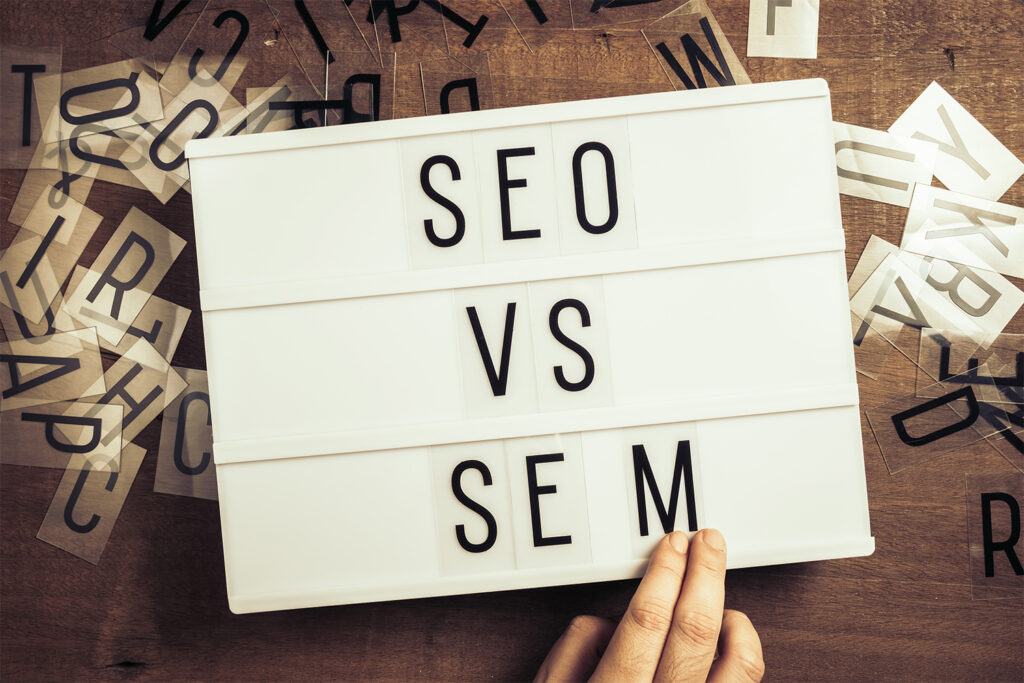SEO and SEM are two of the most powerful acronyms in the marketing world. That being said, there can be a lot of confusion surrounding them. Thankfully, Greg Gillman is here to help you understand the difference between SEO and SEM so that you can choose the right strategy for your brand.
What Is SEO?
Search engine optimization or SEO is an organic marketing tactic that doesn’t involve traditional paid advertising efforts. Instead, SEO involves implementing strategies to boost search result rankings on search engines like Google.
Several different SEO strategies are involved, including on-page SEO, off-page SEO, and technical SEO. For the best results, you should combine all three strategies so that your content can rank number one on Google.
What Is SEM?
On the other hand, search engine marketing involves paying for advertising placements on search engines like Google. For instance, brands can utilize Google Ads to set up advertising campaigns that target specific keywords. Within these campaigns, you can also set budgets, timeframes and monitor your results along the way.
What’s the Difference?
The main difference between SEO and SEM relates to how search results appear. With SEM, your content appears with an “ad” designation with ad extensions that indicate that it’s a paid campaign. There is no such designation with SEO since it hasn’t been paid for — it’s all organic.
Another difference relates to cost. With SEM, you’re going to pay each time someone clicks on your advertisement. Depending on how competitive your keyword is, you could end up paying anywhere from $1 to $2 per click. And while you’re able to set up a bid strategy and set campaign budgets, these clicks can add up quickly.
With SEO, you don’t pay for any clicks. That’s not to say that SEO is free, though. Instead, you pay for the work it takes to develop and build your SEO strategy. SEO is more of a long-term strategy that takes time to develop and build. SEM, on the other hand, provides you with near-immediate results.
Do You Have to Choose One?
There are advantages and disadvantages of both SEO and SEM. So do you have to choose one, or can you take advantage of both of them simultaneously? The good news is that you don’t have to choose between SEO and SEM.
However, if you’re still trying to get a better understanding of which one would work better for your brand, here are some tips to help guide you:
- If you have a brand new business and need to get your name out there, SEM might be your best approach. As you build your online presence, you can start working on SEO as more of a long-term strategy.
- If there’s a lot of competition out there for your target keywords, then SEM might be the best approach for you. However, if there are plenty of gaps that you can fill with your organic content, then you may want to try out SEO.
- If there’s too much competition for your target keywords to the point that the costs-per-click is out of your budget, then you may want to consider SEO for a more cost-effective strategy.
How to Utilize SEO?
As you now know, SEO is a long-term strategy that will take time and effort to implement effectively. Let’s explore the three different SEO techniques and how you can utilize each of them to boost your ranking on Google:
- On-page SEO: On-page SEO involves optimizing your website so that search engines can better recognize your website and its content. The best way to do this is to include your main keyword in your title tag, meta description, and webpage URL so that the search engine algorithm picks up on this and ranks you accordingly. On-page SEO also involves keyword research to decide which keywords you want to rank in, how popular they are, and how competitive they are.
- Off-page SEO: Off-page SEO involves boosting your website’s reputation and authority by creating associations with high-quality and well-known websites. This is primarily done through “backlinking,” wherein other websites are linking back to yours. The search engine algorithm interprets these backlinks as an indication of a reputable and trustworthy website and ranks you higher as a result.
- Technical SEO: Technical SEO involves optimizing the behind-the-scenes aspects of your website. Within technical SEO, website speed is incredibly important. Security is another important factor. You want to make your website as user-friendly as possible to get the best rankings.
How to Utilize SEM?
Although SEM can earn you instant results, this only applies if you utilize it correctly. Here’s what you need to do to implement a successful SEM strategy for your new and growing brand:
- Keyword research: Similar to SEO, keyword research is equally as important as SEM. With SEM, you need to know which keywords you want to bid on and how much you can generally expect to pay.
- Bidding: Once you have narrowed down your target keywords, you need to develop a bidding strategy. Google Ads uses an auction process to select and place paid advertisements. You will need to determine how much you’re willing to pay per click.
- Quality score: The great thing about Google Ads is that the amount of your bid isn’t the only determining factor. If it was, more established companies with larger advertising budgets would have a huge advantage. Instead, Google Ads takes into account both your bid and something called a “quality score.” Your quality score or QS considers your click-through rate (CTR), keyword relevance, landing page quality, landing page relevance, and ad text relevance to make sure that the chosen keyword and content will be helpful to the user.
- Campaign tracking: Your SEM work isn’t over just because your campaign has gone live! Instead, you need to constantly track the progress and success of your campaign as it runs. If it’s underperforming in any area, you can make the necessary changes to get it back on track.
How to Effectively Combine the Two?
So how can you get the best of both worlds with SEO and SEM? Here are some ways that you can effectively combine both SEO and SEM:
- One of the biggest strengths of SEM relates to the data and insights it can provide. But this information isn’t just useful for SEM — you can also use it to improve your SEO efforts. For instance, you can check keyword performances, conversion rates, and traffic opportunities to ensure that you’re using the right keywords.
- Another way that you can combine both SEO and SEM involves remarketing. You can create remarketing SEM campaigns that target users that did not convert through SEO alone. These campaigns can be incredibly successful since these users are already familiar with your brand and are more likely to convert as a result.
Final Thoughts on SEO and SEM
If you’re looking to jump-start your SEO and SEM strategies, you need to reach out to Greg Gillman. Greg Gillman specializes in omnichannel growth strategies for direct-to-consumer brands. He has helped businesses big and small generate $4 billion in annual revenue, so whether you’re just starting or are looking to expand into new areas, he can help you achieve your goals.
Sources:
SEM vs. SEO: What’s the Difference and Which Is Right for My Brand? | Alexa
4 Keyword Search Strategies to Grow Your Business | Entrepreneur
Quality Score: Do You Know Your Number and What It Means for Your Business? | Forbes


